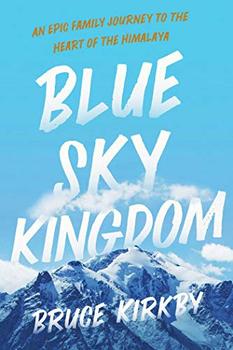Summary | Excerpt | Reading Guide | Reviews | Beyond the Book | Read-Alikes | Genres & Themes | Author Bio

An Epic Family Journey to the Heart of the Himalaya
by Bruce KirkbyThis article relates to Blue Sky Kingdom
In today's world, art therapy has become an increasingly popular option. According to the American Art Therapy Association (AATA), this experiential treatment "is used to improve cognitive and sensorimotor functions, foster self-esteem and self-awareness, cultivate emotional resilience, promote insight, enhance social skills, reduce and resolve conflicts and distress, and advance societal and ecological change." Yet the cathartic qualities of art are ancient. Buddhist monks frequently use art for similar purposes in their rituals.
In Blue Sky Kingdom, Bruce Kirkby describes the painstakingly slow and exacting process of making a mandala — an extraordinarily intricate painting created from colored sand, in this instance to honor the harvest. Lamas are each assigned a quadrant after studying complicated plans and must match the colors exactly. The work is so exacting that, as Kirkby notes, "even a few errant grains could induce a catastrophic unravelling." Monks use a long narrow funnel known as a "chak-pur" to aid in the construction. Despite the tremendous efforts to create these fantastic works of art, mandalas are ultimately destroyed to underscore the Buddhist idea of impermanence.
The process is symbolic of life itself and shows major differences between ancient culture and today's frenetic world. In a land of instant gratification, such a slow and arduous task seems unfathomable. Even more incredible is the thought of destroying it, given modern rampant materialism and love for "things." Yet this process symbolizes the cycle in which we painstakingly create a life, hopefully one that is multi-faceted and beautiful, only to have it end. The key to creating a mandala is mindful attention. Perhaps therein lies the lesson for extending the metaphor to our own lives.
So too are thankas symbolic. Upon the close of their trip, the Kirkbys inquire about purchasing thankas, Buddhist paintings that adorn the monastery halls. Kirkby thinks Lama Wagyal, his host, is dismissive when he asks about them, yet the Lama commissions someone to create a painting for each member of the family, based upon their birth dates and events surrounding their births. Additionally, the Lama performs a blessing puja, a ritual of worship, as "an unblessed thanka was of no use at all." Each thanka has deep symbolic significance, as it depicts Buddha in various poses.
As with mandalas, thankas are meant to promote a deeper understanding and reinforce the tenets of Buddhism. Thankas include certain standard symbols such as the lotus flower, the parasol and the conch shell, each reinforcing an aspect of the teachings of Buddha. The puja performed for the Kirkbys' thankas also involves the destruction of statues to underscore the impermanence of life.
Kirkby seems to sense the metaphorical value of the mandalas in particular as he watches the lamas work in tandem, yet with their individual methods: "Each worked at his own pace and rhythm, and slowly a splendor of motifs bloomed: scepters, flames, flowers, castles and thunderbolts. But no one got too far ahead of the others, and there was a unity to their progress."
Monks working on sand mandala, by Mozart Diensthuber (CC BY 3.0)
Filed under Places, Cultures & Identities
![]() This "beyond the book article" relates to Blue Sky Kingdom. It originally ran in November 2020 and has been updated for the
July 2022 paperback edition.
Go to magazine.
This "beyond the book article" relates to Blue Sky Kingdom. It originally ran in November 2020 and has been updated for the
July 2022 paperback edition.
Go to magazine.
Common sense is genius dressed in its working clothes.
Click Here to find out who said this, as well as discovering other famous literary quotes!
Your guide toexceptional books
BookBrowse seeks out and recommends the best in contemporary fiction and nonfiction—books that not only engage and entertain but also deepen our understanding of ourselves and the world around us.